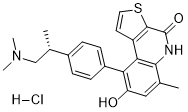OTS964 HCl, the hydrochloride salt of OTS-964 and a dimethylated derivative of OTS 514, is a potent and selective inhibitor of TOPK (T-lymphokine-activated killer cell-originated protein kinase) with antitumor effects. With a high affinity and selectivity, it inhibits TOPK (IC50 = 28 nM). TOPK, a protein that is overexpressed in a number of cancers and tumors, is thought to function as an oncogene that encourages the growth of tumors. OTS964 may therefore have anticancer properties because it is a TOPK inhibitor. Both in vitro and in xenograft models of human lung cancer, it results in a cytokinesis defect and subsequent apoptosis of cancer cells. OTS964 administered as a liposomal formulation successfully caused total regression of transplanted tumors without causing any adverse reactions in mice, but it also caused hematopoietic adverse reactions (leukocytopenia associated with thrombocytosis).
Physicochemical Properties
| Molecular Formula | C23H24N2O2S.HCL | |
| Molecular Weight | 428.98 | |
| Exact Mass | 428.132 | |
| Elemental Analysis | C, 64.40; H, 5.87; Cl, 8.26; N, 6.53; O, 7.46; S, 7.47 | |
| CAS # | 1338545-07-5 | |
| Related CAS # | OTS964;1338542-14-5 | |
| PubChem CID | 89675898 | |
| Appearance | Off-white to light yellow solid powder | |
| LogP | 5.89 | |
| Hydrogen Bond Donor Count | 3 | |
| Hydrogen Bond Acceptor Count | 4 | |
| Rotatable Bond Count | 4 | |
| Heavy Atom Count | 29 | |
| Complexity | 563 | |
| Defined Atom Stereocenter Count | 1 | |
| SMILES | Cl[H].Cl[H].S1C([H])=C([H])C2=C1C(N([H])C1C(C([H])([H])[H])=C([H])C(=C(C3C([H])=C([H])C(=C([H])C=3[H])[C@@]([H])(C([H])([H])[H])C([H])([H])N(C([H])([H])[H])C([H])([H])[H])C=12)O[H])=O |
|
| InChi Key | YHPWOYBWUWSJDW-UQKRIMTDSA-N | |
| InChi Code | InChI=1S/C23H24N2O2S.ClH/c1-13-11-18(26)19(16-7-5-15(6-8-16)14(2)12-25(3)4)20-17-9-10-28-22(17)23(27)24-21(13)20;/h5-11,14,26H,12H2,1-4H3,(H,24,27);1H/t14-;/m0./s1 | |
| Chemical Name | 9-[4-[(2R)-1-(dimethylamino)propan-2-yl]phenyl]-8-hydroxy-6-methyl-5H-thieno[2,3-c]quinolin-4-one;hydrochloride | |
| Synonyms |
|
|
| HS Tariff Code | 2934.99.9001 | |
| Storage |
Powder-20°C 3 years 4°C 2 years In solvent -80°C 6 months -20°C 1 month Note: Please store this product in a sealed and protected environment, avoid exposure to moisture. |
|
| Shipping Condition | Room temperature (This product is stable at ambient temperature for a few days during ordinary shipping and time spent in Customs) |
Biological Activity
| Targets | TOPK (IC50 = 28 nM); CDK11B (IC50 = 40 nM) | |
| ln Vitro |
|
|
| ln Vivo |
|
|
| Cell Assay | At a specific density, 100 μl of cells are plated in 96-well plates. Prior to being exposed to compounds for 72 hours at 37°C, the cells are given an overnight period to adhere. At 450 nm in wavelength, plates are read using a spectrophotometer. Three duplicates of each assay are run. The z scores are computed to yield P values once the IC50 values have been measured. The log values of the IC50 for each of the 13 TOPK-positive cell lines are transformed to base ten (nM) and the mean and standard deviation are then computed. | |
| Animal Protocol |
Nude mice bearing LU-99 lung cancer cells[1] 40 mg/kg Intravenously; on days 1, 4, 8, 11, 15, and 18 |
|
| References |
[1]. TOPK inhibitor induces complete tumor regression in xenograft models of human cancer through inhibition ofcytokinesis. Sci Transl Med. 2014 Oct 22;6(259):259ra145. [2]. Off-target toxicity is a common mechanism of action of cancer drugs undergoing clinical trials. Sci Transl Med. 2019 Sep 11;11(509). [3]. TOPK inhibits autophagy by phosphorylating ULK1 and promotes glioma resistance to TMZ. Cell Death Dis. 2019 Aug 5;10(8):583. |
Solubility Data
| Solubility (In Vitro) |
|
|||
| Solubility (In Vivo) |
Solubility in Formulation 1: ≥ 2.5 mg/mL (5.83 mM) (saturation unknown) in 10% DMSO + 40% PEG300 + 5% Tween80 + 45% Saline (add these co-solvents sequentially from left to right, and one by one), clear solution. For example, if 1 mL of working solution is to be prepared, you can add 100 μL of 25.0 mg/mL clear DMSO stock solution to 400 μL PEG300 and mix evenly; then add 50 μL Tween-80 to the above solution and mix evenly; then add 450 μL normal saline to adjust the volume to 1 mL. Preparation of saline: Dissolve 0.9 g of sodium chloride in 100 mL ddH₂ O to obtain a clear solution. Solubility in Formulation 2: ≥ 2.5 mg/mL (5.83 mM) (saturation unknown) in 10% DMSO + 90% (20% SBE-β-CD in Saline) (add these co-solvents sequentially from left to right, and one by one), clear solution. For example, if 1 mL of working solution is to be prepared, you can add 100 μL of 25.0 mg/mL clear DMSO stock solution to 900 μL of 20% SBE-β-CD physiological saline solution and mix evenly. Preparation of 20% SBE-β-CD in Saline (4°C,1 week): Dissolve 2 g SBE-β-CD in 10 mL saline to obtain a clear solution. Solubility in Formulation 3: ≥ 2.5 mg/mL (5.83 mM) (saturation unknown) in 10% DMSO + 90% Corn Oil (add these co-solvents sequentially from left to right, and one by one), clear solution. For example, if 1 mL of working solution is to be prepared, you can add 100 μL of 25.0 mg/mL clear DMSO stock solution to 900 μL of corn oil and mix evenly. (Please use freshly prepared in vivo formulations for optimal results.) |
| Preparing Stock Solutions | 1 mg | 5 mg | 10 mg | |
| 1 mM | 2.3311 mL | 11.6556 mL | 23.3111 mL | |
| 5 mM | 0.4662 mL | 2.3311 mL | 4.6622 mL | |
| 10 mM | 0.2331 mL | 1.1656 mL | 2.3311 mL |
